Novel 3D Printing Phase Change Aggregate Concrete: Mechanical and Thermal Properties Analysis
Abstract
1. Introduction
2. Materials and Methods
2.1. 3D Printing Aggregate Preparation
2.2. Other Raw Materials
2.3. Sample Preparation
2.4. Test Methods
- (1)
- Mechanical properties: the loading rate of the cementitious composite sample is 1200 N/s, and three parallel tests are carried out for each group. According to GB/T50081-2019, the concrete compressive and splitting tensile performance tests are carried out. Maintain an ambient temperature of 20 ± 5 °C during the stress test.
- (2)
- Early hydration temperature rise: Set all the raw materials at 20 °C for 24 h until constant temperature, prepare fresh phase change aggregate concrete, and pour into a 1 L cylindrical container with a temperature sensor vertically fixed in the center of the lid and connected to the SV3000 environmental monitoring system on the computer. After measurement, close the lid and make a temperature sensor insert to the core of fresh concrete, put the container as a whole into the incubator, and record the temperature every 1 min.
- (3)
- Temperature regulating performance: paste thermocouple in the center of the two largest planes of basalt aggregate concrete slab and phase change aggregate concrete slab and use a high-power heating lamp to simulate sunlight irradiation on one side. The thermocouple is connected to the ToprietP700 multichannel data recorder and records the temperature at the center of the inner and outer surface of the concrete plate every 5 s. At the same time, RNO PC160 infrared imager produced by Meiketsu E-Commerce Co., Ltd., Shanghai, China, was used to take infrared images of the backlit surface of the concrete slab every 20 min. The test device for the concrete slab is shown in Figure 4.
- (4)
- Thermal insulation performance: the phase change aggregate concrete slab and the basalt aggregate concrete slab were, respectively, combined with five polystyrene thermal insulation boards to make a cube model. All cracks in the model were filled with polyurethane foam sealant. High-power heating lamps were used to simulate sunlight irradiation. Thermocouples are installed in the center of the inner and outer sides of the concrete slab, the body center of the model, and the center of the polystyrene thermal insulation board on the bottom and connected with the TOPEIE TP700 multi-channel data recorder. The temperature is recorded every 5 s. The schematic diagram of the whole test device is shown in Figure 5.
3. Results and Discussions
3.1. Compressive Mechanical Properties
3.2. Influence of Hydration Temperature Rise
3.3. Analysis of Temperature Regulation Performance
3.4. Thermal Insulation Performance Analysis
4. Conclusions
- (1)
- Increasing phase change materials in the cavity of phase change aggregate will improve its mechanical properties. Compared with the phase change aggregate without paraffin adsorption, the compressive strength of the phase change cementitious composite with the internal cavity filled with paraffin increased by 9.9%.
- (2)
- The compressive strength of phase change aggregate concrete is 21.18 MPa, and the specific strength is 11.48 kN·m/kg. The concrete experiences ductile failure with the addition of phase change aggregate of 3D printing. When the replacement rate is 50% and 100%, the compressive peak strain of concrete increases by 48.6% and 239.3%, respectively. The splitting tensile strength was 1.45 MPa. The peak strain is 11.69 × 10−3, nearly 13 times that of basalt aggregate concrete.
- (3)
- The addition of phase change aggregates reduces the hydration heating rate while improving thermal regulating and thermal insulation properties. The phase change aggregate reduced concrete’s early peak hydration temperature by 7.1%. For concrete slabs, phase change aggregates can effectively delay heat transfer. In the thermal insulation experiment, phase change aggregate can effectively store thermal energy, maintain the internal temperature of the model, and improve the thermal insulation performance of phase change concrete.
Author Contributions
Funding
Institutional Review Board Statement
Informed Consent Statement
Data Availability Statement
Acknowledgments
Conflicts of Interest
References
- Xiao, L.; Zhao, M.; Hu, H. Study on Graphene Oxide Modified Inorganic Phase Change Materials and Their Packaging Behavior. J. Wuhan Univ. Technol. Mater. Sci. Ed. 2018, 33, 788–792. [Google Scholar] [CrossRef]
- Chen, X.; Cheng, P.; Tang, Z.; Xu, X.; Gao, H.; Wang, G. Carbon-Based Composite Phase Change Materials for Thermal Energy Storage, Transfer, and Conversion. Adv. Sci. 2021, 8, 2001274. [Google Scholar] [CrossRef] [PubMed]
- Patiño-Cambeiro, F.; Armesto, J.; Bastos, G.; Prieto-López, J.I.; Patiño-Barbeito, F. Economic appraisal of energy efficiency renovations in tertiary buildings. Sustain. Cities Soc. 2019, 47, 101503. [Google Scholar] [CrossRef]
- Song, M.; Jiang, J.; Zhu, J.; Zheng, Y.; Yu, Z.; Ren, X.; Jiang, F. Lightweight, strong, and form-stable cellulose nanofibrils phase change aerogel with high latent heat. Carbohydr Polym 2021, 272, 118460. [Google Scholar] [CrossRef]
- Madad, A.; Mouhib, T.; Mouhsen, A. Phase Change Materials for Building Applications: A Thorough Review and New Perspectives. Buildings 2018, 8, 63. [Google Scholar] [CrossRef]
- Reyez-Araiza, J.L.; Pineda-Pinon, J.; Lopez-Romero, J.M.; Gasca-Tirado, J.R.; Arroyo Contreras, M.; Jauregui Correa, J.C.; Apatiga-Castro, L.M.; Rivera-Munoz, E.M.; Velazquez-Castillo, R.R.; Perez Bueno, J.J.; et al. Thermal Energy Storage by the Encapsulation of Phase Change Materials in Building Elements-A Review. Materials 2021, 14, 1420. [Google Scholar] [CrossRef]
- Memon, S.A. Phase change materials integrated in building walls: A state of the art review. Renew. Sustain. Energy Rev. 2014, 31, 870–906. [Google Scholar] [CrossRef]
- Golestaneh, S.I.; Mosallanejad, A.; Karimi, G.; Khorram, M.; Khashi, M. Fabrication and characterization of phase change material composite fibers with wide phase-transition temperature range by co-electrospinning method. Appl. Energy 2016, 182, 409–417. [Google Scholar] [CrossRef]
- Purohit, B.K.; Sistla, V.S. Crystallization of inorganic salt hydrates in polymeric foam for thermal energy storage application. J. Energy Storage 2017, 12, 196–201. [Google Scholar] [CrossRef]
- Cui, H.; Tang, W.; Qin, Q.; Xing, F.; Liao, W.; Wen, H. Development of structural-functional integrated energy storage concrete with innovative macro-encapsulated PCM by hollow steel ball. Appl. Energy 2017, 185, 107–118. [Google Scholar] [CrossRef]
- Sani, A.K.; Olawoore, I.O.; Singh, R.M. Assessment of impregnating phase change materials into lightweight aggregates for development of thermal energy storage aggregate composites. Constr. Build. Mater. 2021, 305, 124683. [Google Scholar] [CrossRef]
- Rao, V.V.; Parameshwaran, R.; Ram, V.V. PCM-mortar based construction materials for energy efficient buildings: A review on research trends. Energy Build. 2018, 158, 95–122. [Google Scholar] [CrossRef]
- Xu, G.; Leng, G.; Yang, C.; Qin, Y.; Wu, Y.; Chen, H.; Cong, L.; Ding, Y. Sodium nitrate—Diatomite composite materials for thermal energy storage. Sol. Energy 2017, 146, 494–502. [Google Scholar] [CrossRef]
- Zhang, Y.; Zheng, S.; Zhu, S.; Ma, J.; Sun, Z.; Farid, M. Evaluation of paraffin infiltrated in various porous silica matrices as shape-stabilized phase change materials for thermal energy storage. Energy Convers. Manag. 2018, 171, 361–370. [Google Scholar] [CrossRef]
- Umair, M.M.; Zhang, Y.; Iqbal, K.; Zhang, S.; Tang, B. Novel strategies and supporting materials applied to shape-stabilize organic phase change materials for thermal energy storage—A review. Appl. Energy 2019, 235, 846–873. [Google Scholar] [CrossRef]
- Mitran, R.A.; Ionita, S.; Lincu, D.; Berger, D.; Matei, C. A Review of Composite Phase Change Materials Based on Porous Silica Nanomaterials for Latent Heat Storage Applications. Molecules 2021, 26, 241. [Google Scholar] [CrossRef]
- Gao, H.; Wang, J.; Chen, X.; Wang, G.; Huang, X.; Li, A.; Dong, W. Nanoconfinement effects on thermal properties of nanoporous shape-stabilized composite PCMs: A review. Nano Energy 2018, 53, 769–797. [Google Scholar] [CrossRef]
- Huang, X.; Chen, X.; Li, A.; Atinafu, D.; Gao, H.; Dong, W.; Wang, G. Shape-stabilized phase change materials based on porous supports for thermal energy storage applications. Chem. Eng. J. 2019, 356, 641–661. [Google Scholar] [CrossRef]
- da Cunha, S.R.L.; de Aguiar, J.L.B. Phase change materials and energy efficiency of buildings: A review of knowledge. J. Energy Storage 2020, 27, 101083. [Google Scholar] [CrossRef]
- Kant, K.; Shukla, A.; Sharma, A. Advancement in phase change materials for thermal energy storage applications. Sol. Energy Mater. Sol. Cells 2017, 172, 82–92. [Google Scholar] [CrossRef]
- Al-Shannaq, R.; Kurdi, J.; Al-Muhtaseb, S.; Dickinson, M.; Farid, M. Supercooling elimination of phase change materials (PCMs) microcapsules. Energy 2015, 87, 654–662. [Google Scholar] [CrossRef]
- Jamekhorshid, A.; Sadrameli, S.M.; Barzin, R.; Farid, M.M. Composite of wood-plastic and micro-encapsulated phase change material (MEPCM) used for thermal energy storage. Appl. Therm. Eng. 2017, 112, 82–88. [Google Scholar] [CrossRef]
- Alva, G.; Lin, Y.; Liu, L.; Fang, G. Synthesis, characterization and applications of microencapsulated phase change materials in thermal energy storage: A review. Energy Build. 2017, 144, 276–294. [Google Scholar] [CrossRef]
- Pilehvar, S.; Szczotok, A.M.; Rodríguez, J.F.; Valentini, L.; Lanzón, M.; Pamies, R.; Kjøniksen, A.-L. Effect of freeze-thaw cycles on the mechanical behavior of geopolymer concrete and Portland cement concrete containing micro-encapsulated phase change materials. Constr. Build. Mater. 2019, 200, 94–103. [Google Scholar] [CrossRef]
- Cao, V.D.; Pilehvar, S.; Salas-Bringas, C.; Szczotok, A.M.; Rodriguez, J.F.; Carmona, M.; Al-Manasir, N.; Kjøniksen, A.-L. Microencapsulated phase change materials for enhancing the thermal performance of Portland cement concrete and geopolymer concrete for passive building applications. Energy Convers. Manag. 2017, 133, 56–66. [Google Scholar] [CrossRef]
- Pomianowski, M.; Heiselberg, P.; Jensen, R.L.; Cheng, R.; Zhang, Y. A new experimental method to determine specific heat capacity of inhomogeneous concrete material with incorporated microencapsulated-PCM. Cem. Concr. Res. 2014, 55, 22–34. [Google Scholar] [CrossRef]
- Lecompte, T.; Le Bideau, P.; Glouannec, P.; Nortershauser, D.; Le Masson, S. Mechanical and thermo-physical behaviour of concretes and mortars containing phase change material. Energy Build. 2015, 94, 52–60. [Google Scholar] [CrossRef]
- Aguayo, M.; Das, S.; Maroli, A.; Kabay, N.; Mertens, J.C.E.; Rajan, S.D.; Sant, G.; Chawla, N.; Neithalath, N. The influence of microencapsulated phase change material (PCM) characteristics on the microstructure and strength of cementitious composites: Experiments and finite element simulations. Cem. Concr. Compos. 2016, 73, 29–41. [Google Scholar] [CrossRef]
- Vicente, R.; Silva, T. Brick masonry walls with PCM macrocapsules: An experimental approach. Appl. Therm. Eng. 2014, 67, 24–34. [Google Scholar] [CrossRef]
- Cui, Y.; Xie, J.; Liu, J.; Pan, S. Review of Phase Change Materials Integrated in Building Walls for Energy Saving. Procedia Eng. 2015, 121, 763–770. [Google Scholar] [CrossRef]
- Gallart-Sirvent, P.; Martín, M.; Villorbina, G.; Balcells, M.; Solé, A.; Barrenche, C.; Cabeza, L.F.; Canela-Garayoa, R. Fatty acid eutectic mixtures and derivatives from non-edible animal fat as phase change materials. RSC Adv. 2017, 7, 24133–24139. [Google Scholar] [CrossRef]
- Maier, M.; Salazar, B.; Unluer, C.; Taylor, H.K.; Ostertag, C.P. Thermal and mechanical performance of a novel 3D printed macro-encapsulation method for phase change materials. J. Build. Eng. 2021, 43, 103124. [Google Scholar] [CrossRef]
- Yuan, X.; Wang, B.; Chen, P.; Luo, T. Study on the Frost Resistance of Concrete Modified with Steel Balls Containing Phase Change Material (PCM). Materials 2021, 14, 4497. [Google Scholar] [CrossRef] [PubMed]
- Vérez, D.; Borri, E.; Crespo, A.; Mselle, B.D.; de Gracia, Á.; Zsembinszki, G.; Cabeza, L.F. Experimental Study on Two PCM Macro-Encapsulation Designs in a Thermal Energy Storage Tank. Appl. Sci. 2021, 11, 6171. [Google Scholar] [CrossRef]
- Kim, Y.-R.; Khil, B.-S.; Jang, S.-J.; Choi, W.-C.; Yun, H.-D. Effect of barium-based phase change material (PCM) to control the heat of hydration on the mechanical properties of mass concrete. Thermochim. Acta 2015, 613, 100–107. [Google Scholar] [CrossRef]
- Sukontasukkul, P.; Uthaichotirat, P.; Sangpet, T.; Sisomphon, K.; Newlands, M.; Siripanichgorn, A.; Chindaprasirt, P. Thermal properties of lightweight concrete incorporating high contents of phase change materials. Constr. Build. Mater. 2019, 207, 431–439. [Google Scholar] [CrossRef]
- Pop, O.G.; Fechete Tutunaru, L.; Bode, F.; Abrudan, A.C.; Balan, M.C. Energy efficiency of PCM integrated in fresh air cooling systems in different climatic conditions. Appl. Energy 2018, 212, 976–996. [Google Scholar] [CrossRef]
- Pongsopha, P.; Sukontasukkul, P.; Phoo-ngernkham, T.; Imjai, T.; Jamsawang, P.; Chindaprasirt, P. Use of burnt clay aggregate as phase change material carrier to improve thermal properties of concrete panel. Case Stud. Constr. Mater. 2019, 11, e00242. [Google Scholar] [CrossRef]

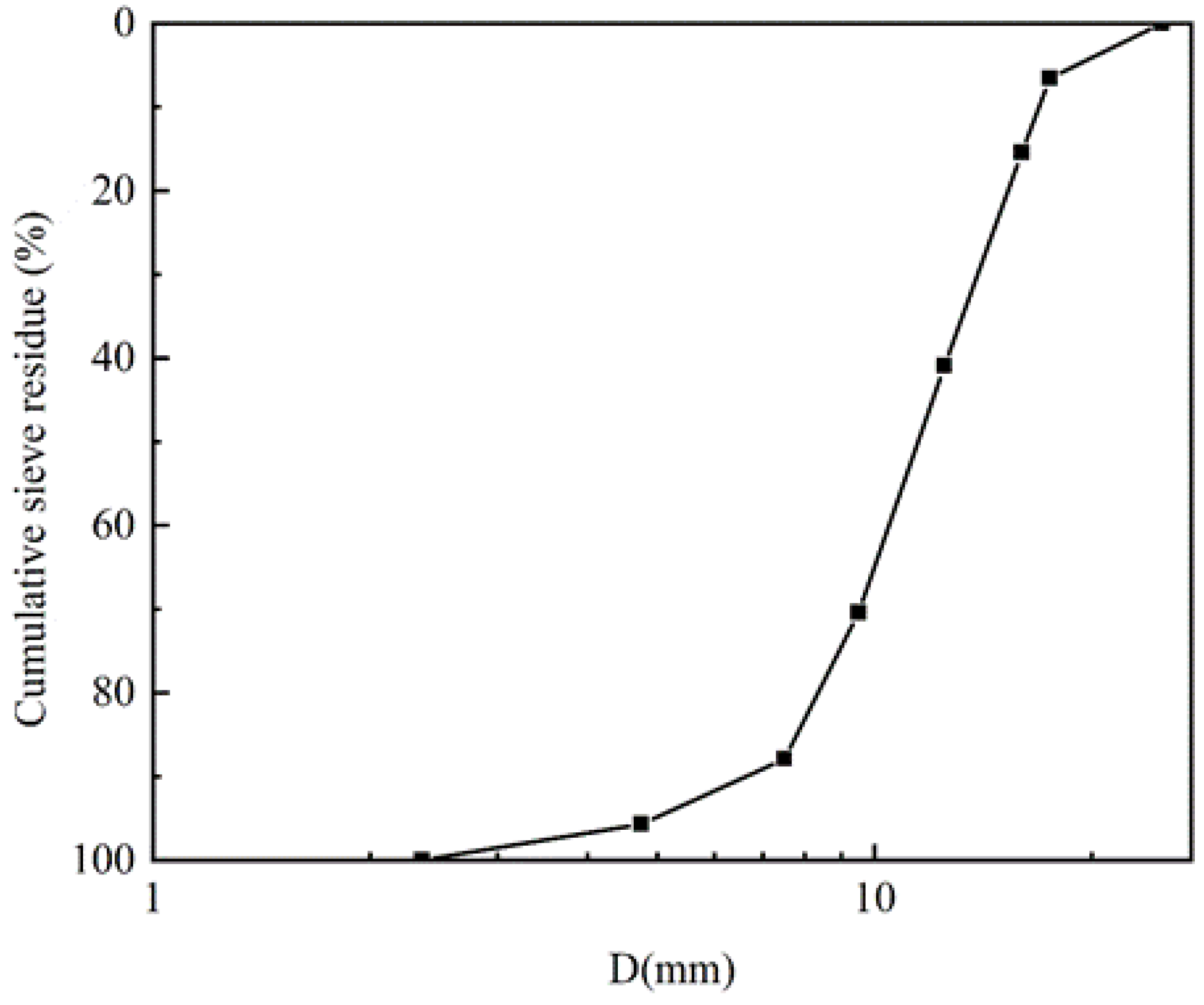



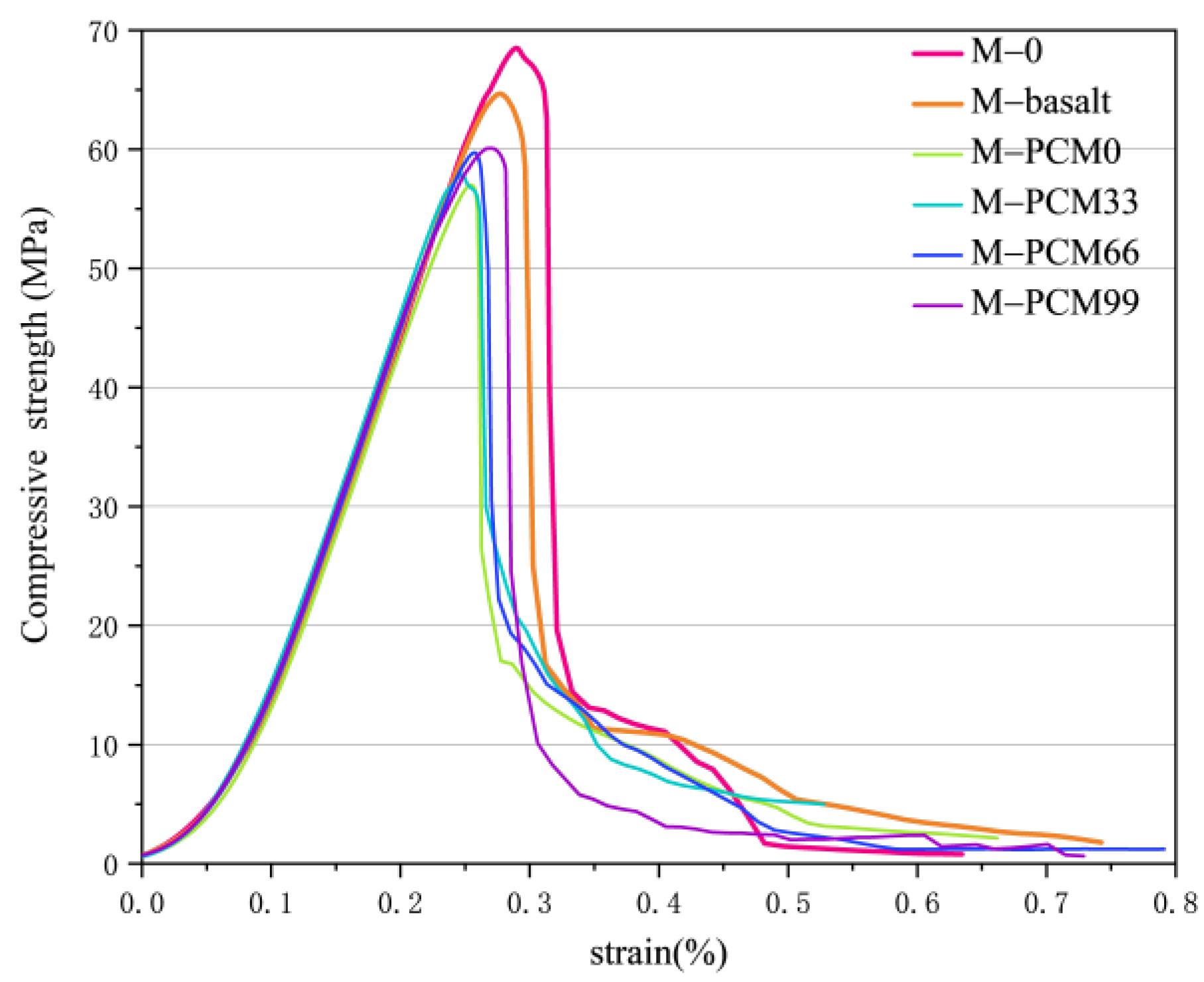



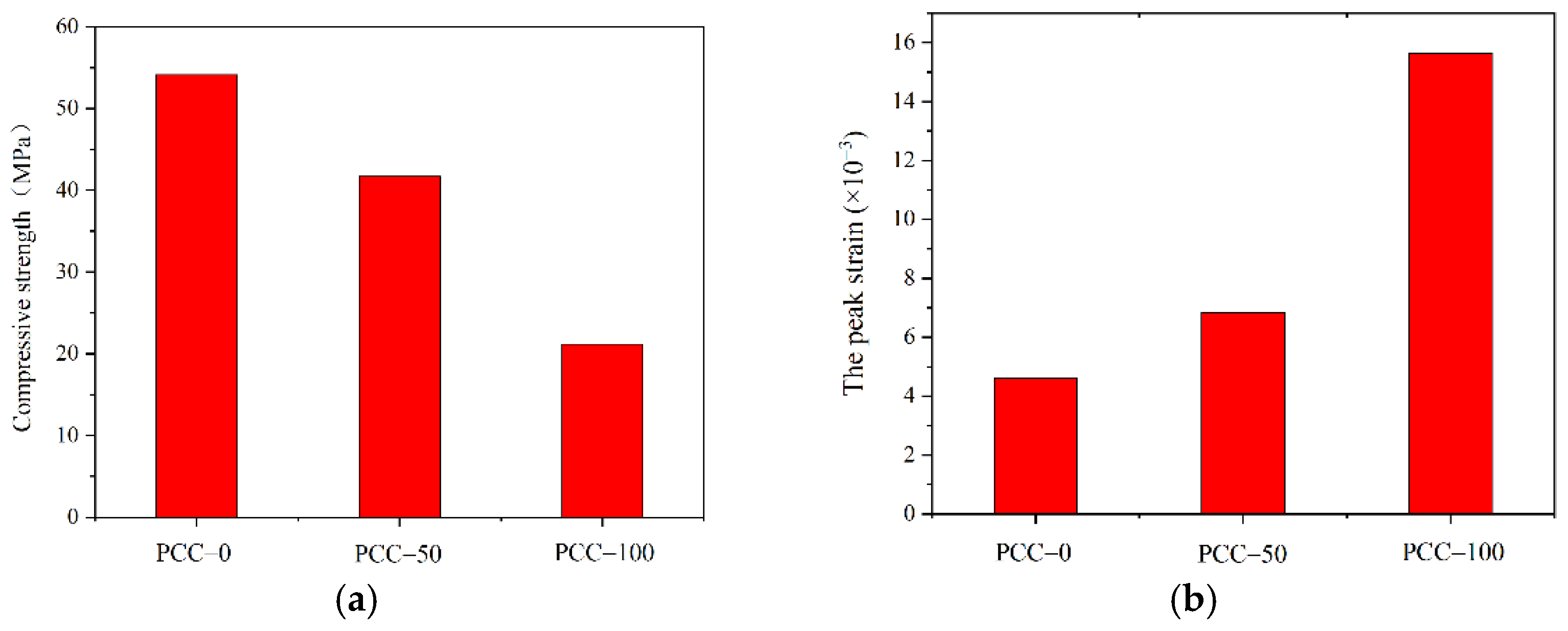
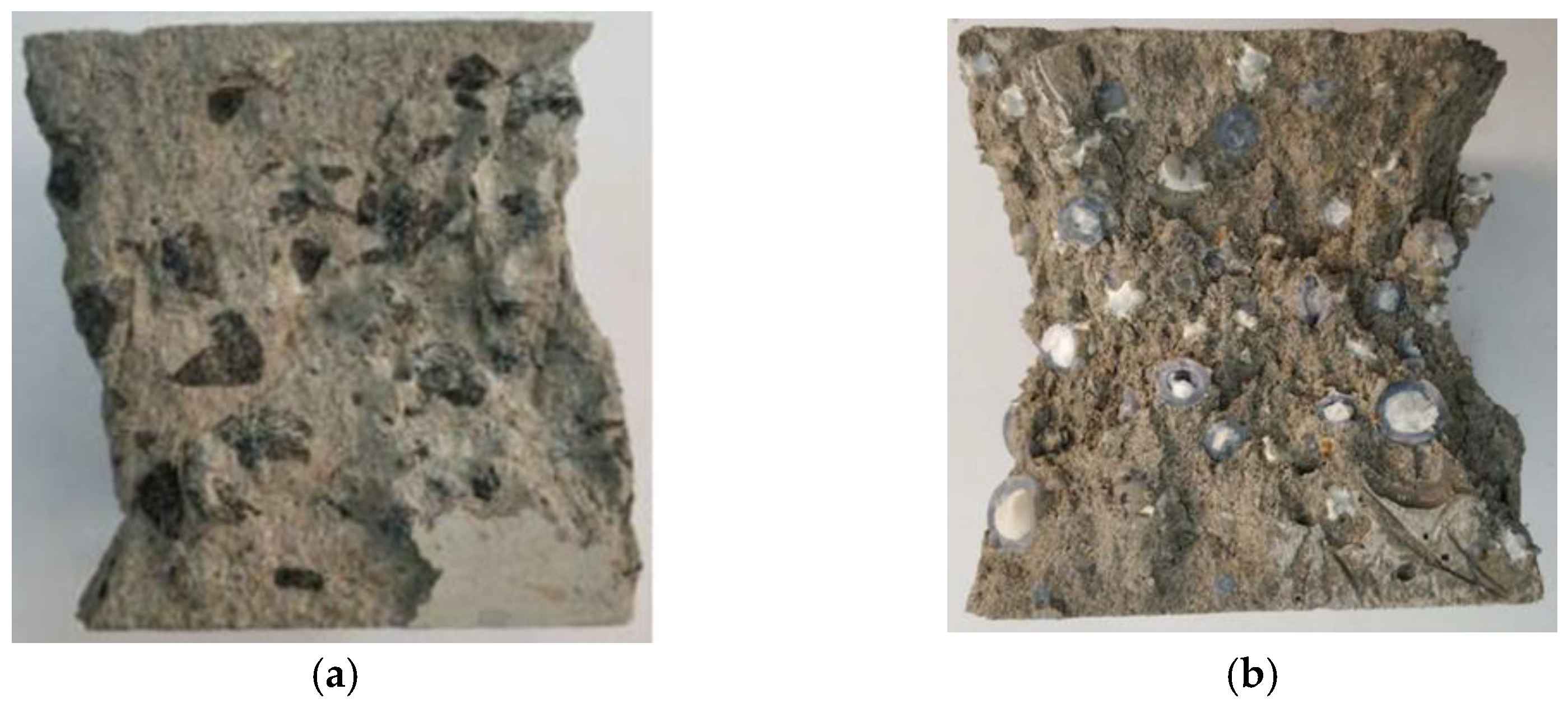
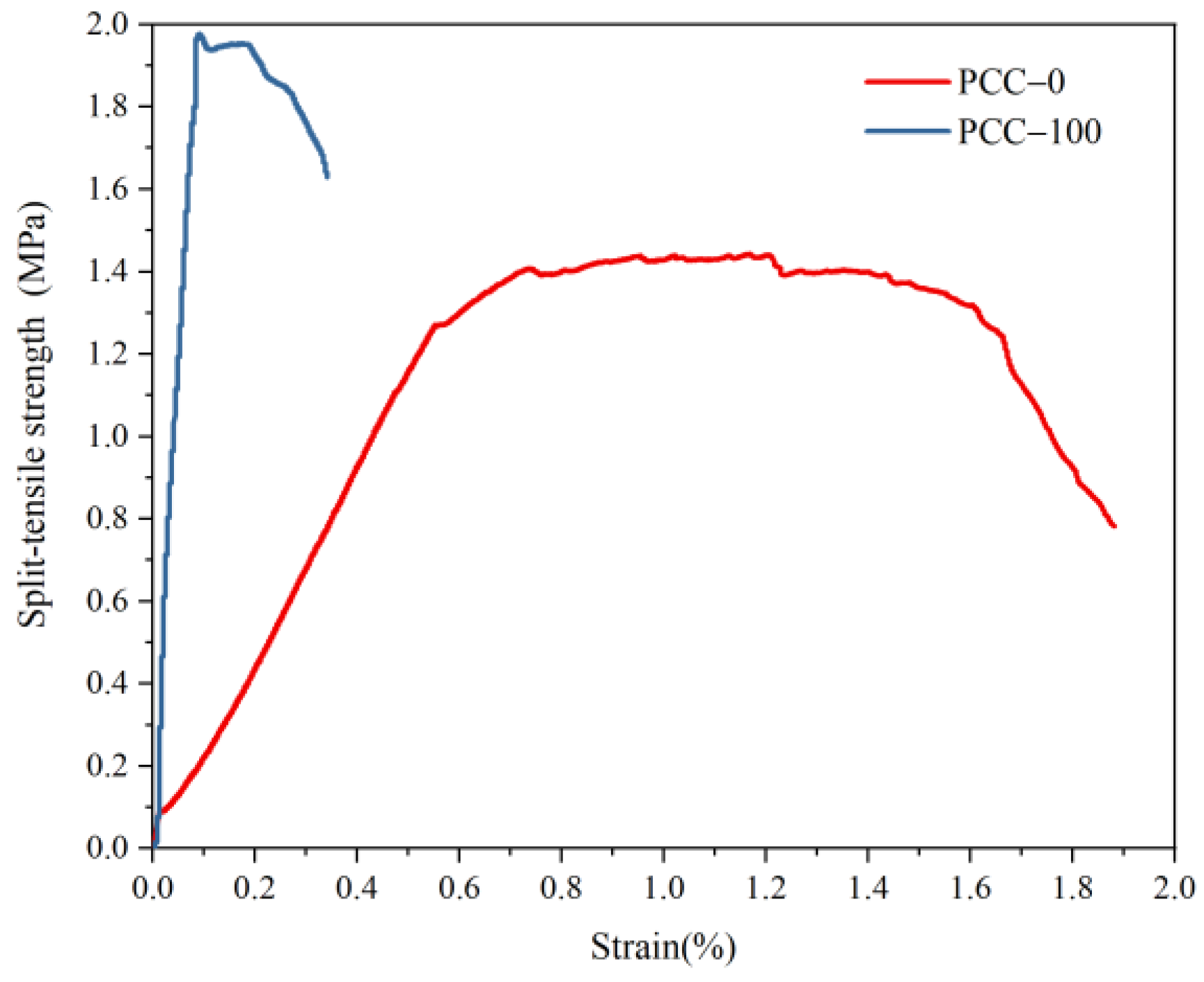

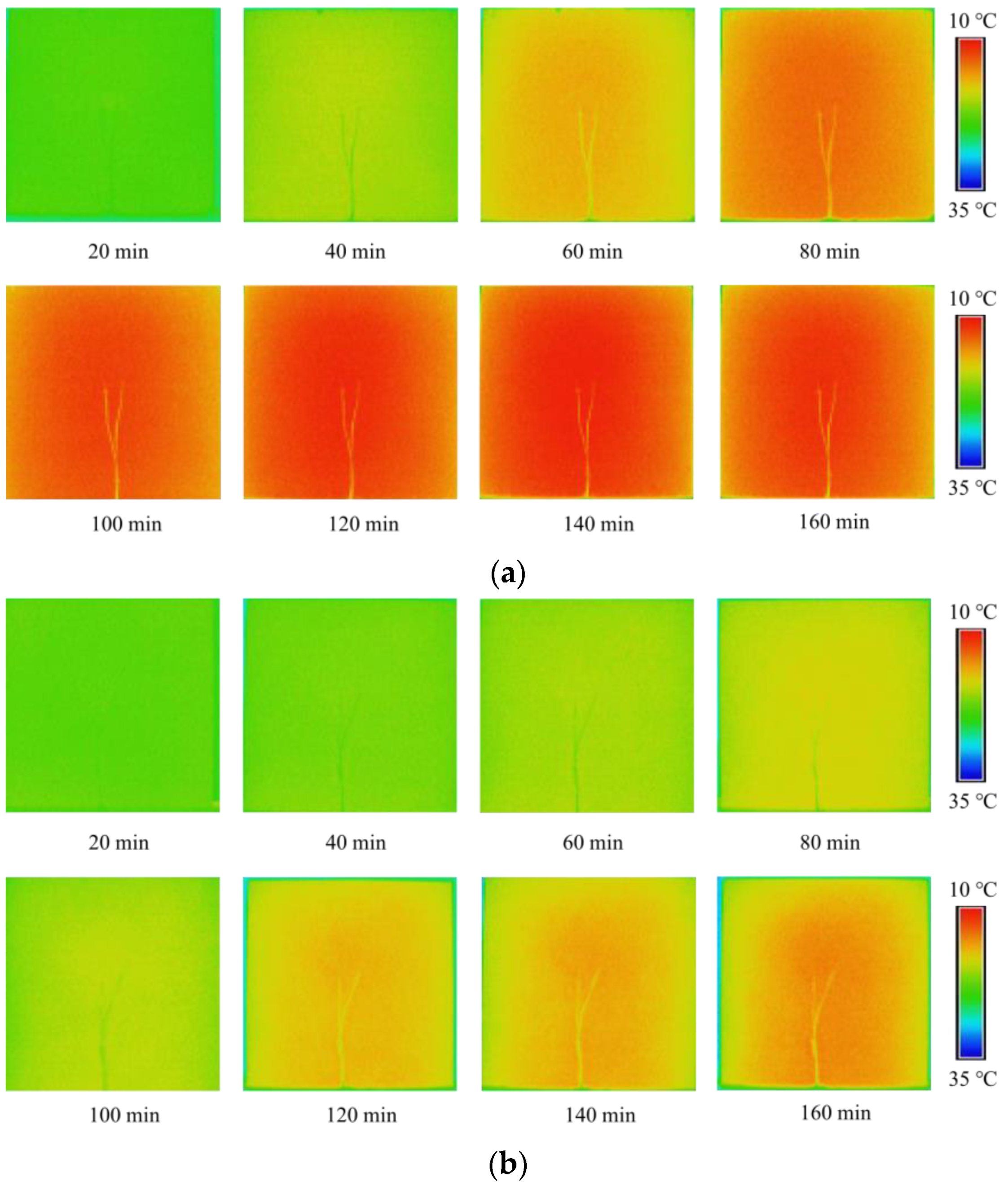
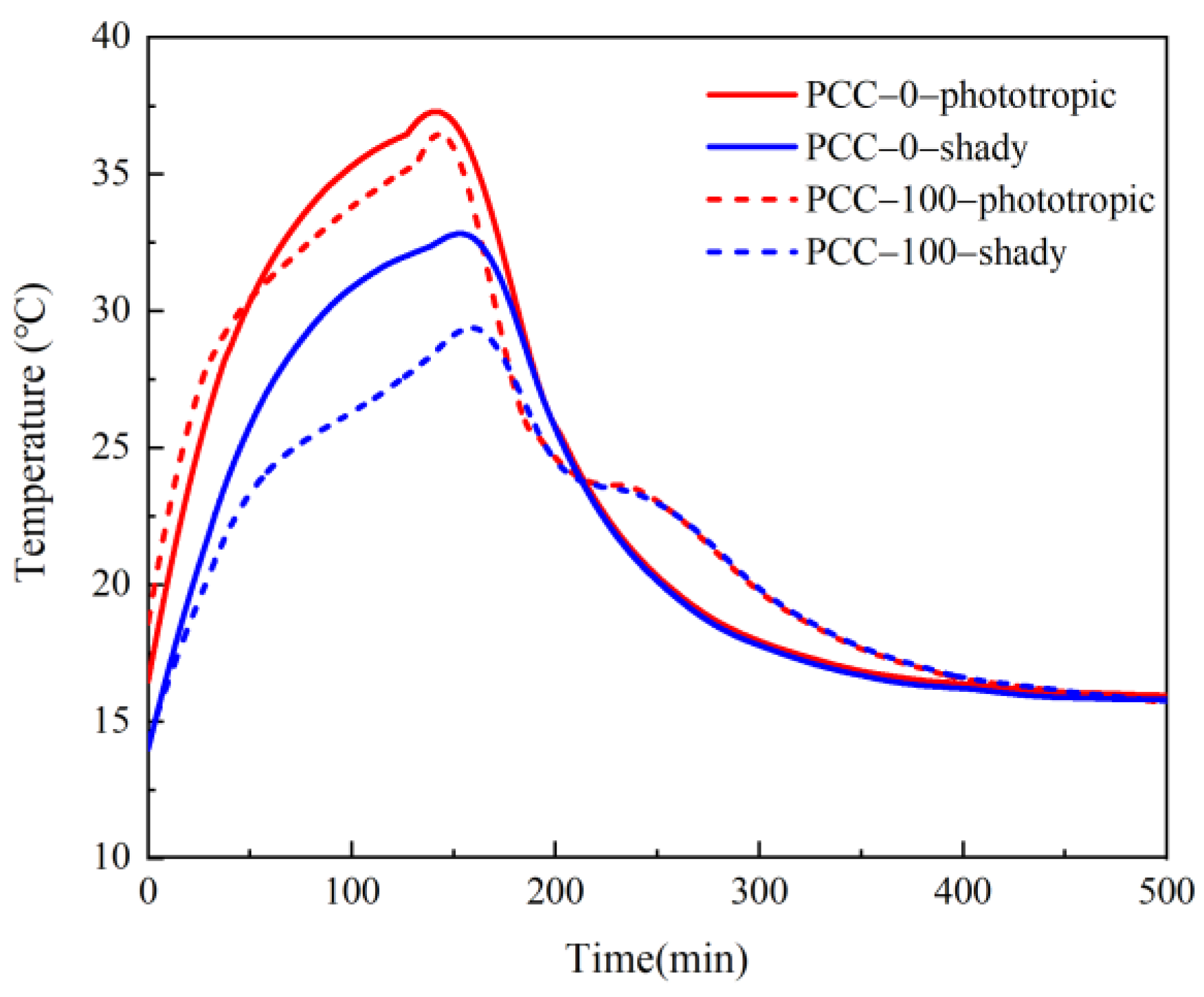

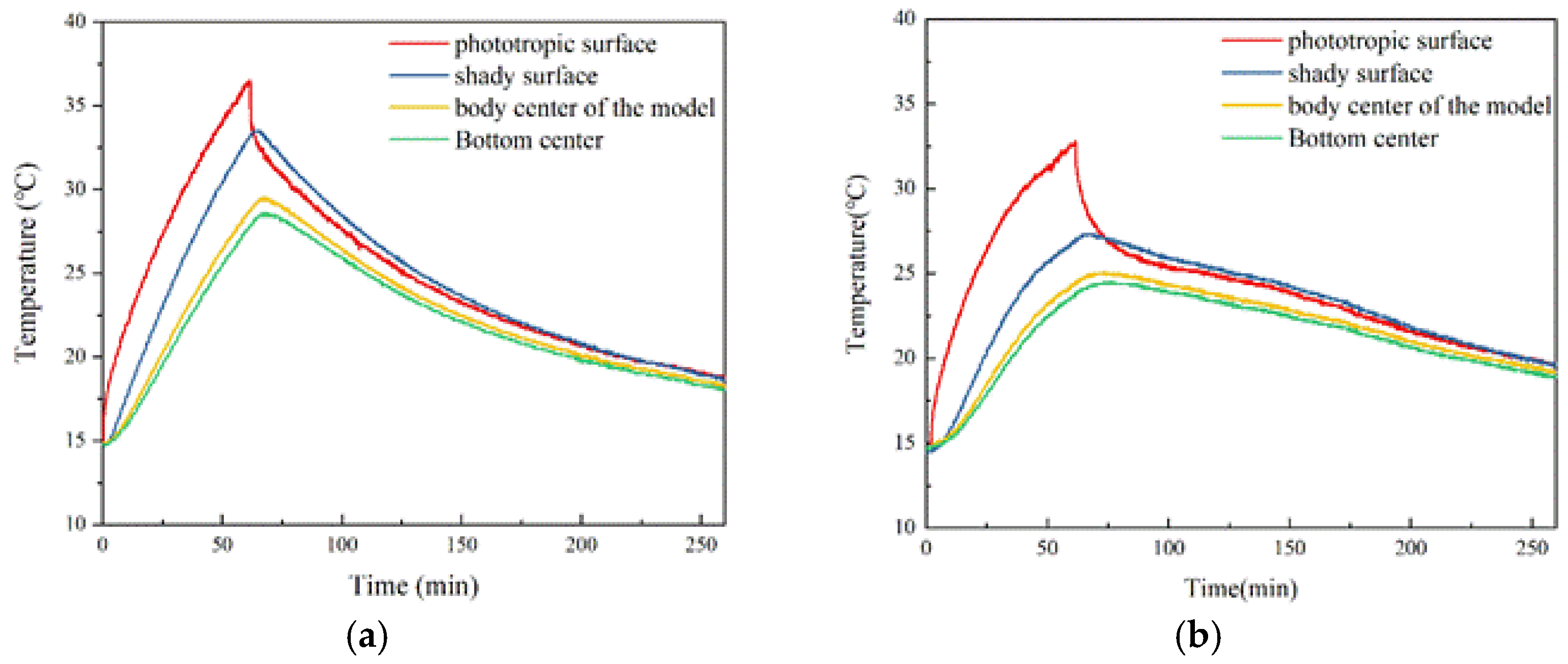

| D (mm) | 2.36 | 4.75 | 7.5 | 9.5 | 12.5 | 16 | 17.5 |
| Wt (%) | 4.30 | 7.79 | 17.46 | 29.51 | 25.50 | 8.87 | 6.57 |
| Chemical Composition | CaO | SiO2 | Al2O3 | Fe2O3 | MgO | SO3 |
|---|---|---|---|---|---|---|
| content (%) | 63.62 | 20.13 | 4.71 | 3.35 | 1.26 | 2.85 |
| Chemical Composition | CaO | SiO2 | Al2O3 | Fe2O3 | MgO | SO3 | Na2O | TiO2 |
|---|---|---|---|---|---|---|---|---|
| content (%) | 7.62 | 48.3 | 28.7 | 7.2 | 1.29 | 0.95 | 0.86 | 1.46 |
| Aggregate (Number) | PCMs Filling Rate | Cement (kg) | Fly Ash (kg) | Sand (kg) | Water (kg) | Superplasticizer (kg) | |
|---|---|---|---|---|---|---|---|
| M−0 | 0 | 0 | 355.88 | 100.35 | 798.41 | 182.24 | 0.57 |
| M−basalt | 6 | 0 | 355.88 | 100.35 | 798.41 | 182.24 | 0.57 |
| M−PCM0 | 6 | 0 | 355.88 | 100.35 | 798.41 | 182.24 | 0.57 |
| M−PCM33 | 6 | 33% | 355.88 | 100.35 | 798.41 | 182.24 | 0.57 |
| M−PCM66 | 6 | 66% | 355.88 | 100.35 | 798.41 | 182.24 | 0.57 |
| M−PCM99 | 6 | 99% | 355.88 | 100.35 | 798.41 | 182.24 | 0.57 |
| Basalt Aggregate (kg) | Phase Change Aggregate (kg) | Cement (kg) | Fly Ash (kg) | Sand (kg) | Water (kg) | Superplasticizer (kg) | |
|---|---|---|---|---|---|---|---|
| PCC−0 | 1016.16 | 0 | 355.88 | 100.35 | 798.41 | 182.24 | 0.57 |
| PCC−50 | 508.08 | 182.25 | 355.88 | 100.35 | 798.41 | 182.24 | 0.57 |
| PCC−100 | 0 | 364.51 | 355.88 | 100.35 | 798.41 | 182.24 | 0.57 |
Publisher’s Note: MDPI stays neutral with regard to jurisdictional claims in published maps and institutional affiliations. |
© 2022 by the authors. Licensee MDPI, Basel, Switzerland. This article is an open access article distributed under the terms and conditions of the Creative Commons Attribution (CC BY) license (https://creativecommons.org/licenses/by/4.0/).
Share and Cite
Jiang, J.; Zheng, C.; Wang, F.; Xu, W.; Wang, L.; Chen, Z.; Su, W. Novel 3D Printing Phase Change Aggregate Concrete: Mechanical and Thermal Properties Analysis. Materials 2022, 15, 8393. https://doi.org/10.3390/ma15238393
Jiang J, Zheng C, Wang F, Xu W, Wang L, Chen Z, Su W. Novel 3D Printing Phase Change Aggregate Concrete: Mechanical and Thermal Properties Analysis. Materials. 2022; 15(23):8393. https://doi.org/10.3390/ma15238393
Chicago/Turabian StyleJiang, Jinyang, Chaolang Zheng, Fengjuan Wang, Wenxiang Xu, Liguo Wang, Zhaoyi Chen, and Wei Su. 2022. "Novel 3D Printing Phase Change Aggregate Concrete: Mechanical and Thermal Properties Analysis" Materials 15, no. 23: 8393. https://doi.org/10.3390/ma15238393
APA StyleJiang, J., Zheng, C., Wang, F., Xu, W., Wang, L., Chen, Z., & Su, W. (2022). Novel 3D Printing Phase Change Aggregate Concrete: Mechanical and Thermal Properties Analysis. Materials, 15(23), 8393. https://doi.org/10.3390/ma15238393






